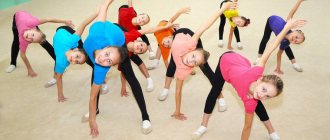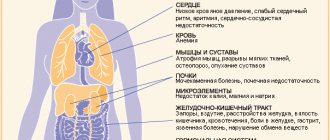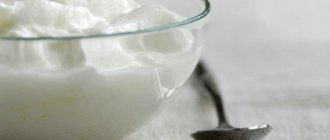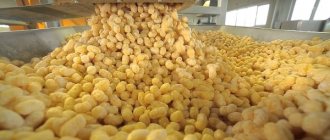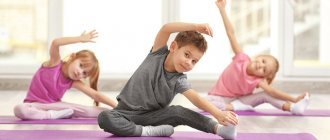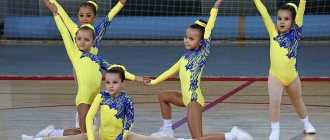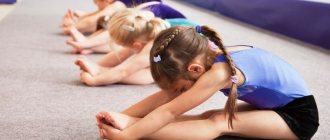There is no more favorable time for the development of physical and mental qualities than childhood.
It is very important to understand that there are special stages in a child’s development - the so-called “sensitive” periods. This is the time when one of the physical qualities (strength, coordination, flexibility, speed, endurance) develops especially intensively. It is important not to miss this time and give the child the opportunity to develop physical qualities through fitness.
We have all seen people who are, as they say, “naturally clumsy.” So, they are clumsy not by nature, but precisely because the “sensitive” period of development in childhood was missed.
Nowadays, terrible school overload and a sedentary lifestyle have become the talk of the town. Active yard games are a thing of the past: for boys - Cossacks-robbers, lapta, towns, etc.; for girls - hopscotch, jump ropes, various ball games, etc. Today's children often find relaxation in cartoons on children's TV channels and computer games.
There is no outlet for the huge reserve of children's energy inherent in nature. There is an opinion that it is precisely this narrow-mindedness within the framework of “school-home-computer” that gives rise to further outbreaks of teenage aggression.
Of course, there is a way out - this is an instilled in the child’s desire to engage in fitness, sports games and any type of physical activity. The child’s body must regularly receive portions of healthy physical activity in order to develop according to the canons laid down by nature.
Moreover, fitness should not be considered as a narrowly training element. Fitness for children is, first of all, exciting and active activities. It is better in the fresh air, with elements of games, various exercises, in an atmosphere of sports excitement.
The main thing is to take into account the age characteristics of the child when doing fitness.
The influence of fitness on the development and health of children
Such training increases self-confidence and gives positive emotions. Special programs are focused on strengthening all muscle groups. They allow you to keep your child's body in proper tone. Fitness training improves coordination of movements, increases mobility and flexibility of joints.
Such activities contribute to the formation of a muscular corset. Training complexes comprehensively develop the child’s body and have a positive effect on the functioning of the cardiovascular and vestibular apparatus, respiratory and other functional systems.
Fitness for children 10-12 years old is an important factor in a healthy lifestyle and socially oriented behavior. At this age, a child has an increased biological need for physical activity.
Its quantitative characteristics are determined by:
- gender identity;
- body type;
- level of physical development;
- features of higher nervous activity;
- sometimes years;
- climatic conditions;
- physiological capabilities of a growing body.
Fitness classes have a significant impact on the physical parameters of the body, the formation and development of cerebral structures. Muscle contractions during training stimulate cerebral circulation, which contributes to the improvement of analyzer systems.
Main areas of physical education for children 10–12 years old
There are a large number of varieties of programs for such training complexes. New areas of children's fitness are constantly being developed, due to its growing popularity and importance for the harmonious development of schoolchildren.
Currently existing types of children's fitness:
| Direction | Description and characteristics |
| Fit Ball | Exercises with balls that effectively develop the musculoskeletal system. They include a large number of training programs and exercises. |
| Step by Step | Step training, during which gait improves. Develops balance and motor skills. |
| Baby Top | A direction designed to prevent and correct childhood flat feet. Trainings are conducted with musical accompaniment, which helps trainees develop a sense of rhythm and synchronization of movements. |
| Children's yoga | Improves psycho-emotional state, promotes self-control. Precisely calculated physical activity develops flexibility. It is considered an ideal fitness destination for hyperactive teenagers. |
| Logo aerobics | Improves speech skills and diction, as during training children recite poetry and pronounce motivational non-rhyming phrases. Develops respiratory activity. |
| Aqua aerobics | Exercising in the pool improves metabolism and appetite, and forms correct posture. Aqua aerobics is an excellent prevention of colds. It strengthens the body. |
| Parkour | Allows children to explore the capabilities of their own bodies. Develops endurance and promotes liberation. |
For children of this age, moderate strength training is recommended to increase physical potential and promote muscle gain. Trampoline exercises allow you to practice jumping techniques and improve coordination of movements.
An approximate algorithm for bodybuilding classes for teenagers:
12-16 years:
It’s too early for you to start working with serious weights and exercises with weights, so your priority should be exercises with your own weight - pull-ups, crunches and hyperextensions, squats without weights, swimming, running, rope climbs, etc. You may think that you are already mature enough to move on to barbell training, but believe me:
- By doing exclusively the exercises listed above, it is quite possible to build a beautiful figure for a teenager!
- Health is more valuable! Don't get me wrong - working out in the gym is not dangerous if you have experience, have developed the correct technique for doing the exercises and have a formed skeleton. Otherwise, you can easily get injured, which, at best, will delay your desired figure for many months, and at worst, ruin your health forever.
17-19 years old:
You can gradually introduce heavy exercises with a barbell, and begin classes according to a simplified “adult” training program. If you were involved in fitness at an earlier age, then the transition will go smoothly and without trouble, and your body will transform before your eyes from a child’s to a man’s!
Features of children's training
Fitness classes may include choreographic and gymnastic exercises. Children's training programs differ significantly from those for adults. Sports activities are conducted in a playful manner.
This approach reduces stress and gives children pleasure. Often groups consist of 10-15 children. It is important not to cause overwork, so a gentle regime of physical activity is used. Emphasizes cardio exercises.
Fitness for children 10-12 years old is carried out in specially adapted halls and swimming pools. They have swings, slides, wall bars and other equipment necessary for classes.
Strength training for teenagers
The peculiarity of training for teenagers from Yuri Spasokukotsky is that the program consists of several levels. From easy exercises to develop the muscles of the whole body, young people gradually move on to more complex exercises, divided by muscle groups.
We will tell you about the initial level of the training program for teenagers from Yuri Spasokukotsky. These exercises are designed to prepare the body for physical activity, which is why they are called basic or simply “base”. Gradually increasing the complexity of the exercises, you will properly develop your muscles, joints and ligaments without harm to your health.
The first level training program presented below can be performed or even.
Pros and cons of children's fitness
Comprehensive programs are developed taking into account the age and physiological development of each child. Group classes help develop communication skills and the ability to interact with peers.
Other benefits of children's fitness include:
- effective strengthening of muscles and formation of skeletal structures;
- improving coordination capabilities;
- formation of correct posture and proportional anthropometry of the body;
- increasing the flexibility of ligaments, tendons and joints;
- development of strength characteristics and dynamic endurance;
- prevention of cardiovascular, colds, respiratory and neurological diseases;
- stimulation of immunity;
- general healing effect on the body;
- socialization of children;
- ability to solve communicative problems;
- facilitating adaptation to society;
- instilling discipline, self-organization, and concentration.
Among the disadvantages of classes, the risk of injury and the likelihood of psychological difficulties are noted, since all children at this age have different levels of physical, emotional and intellectual development.
Types of fitness for children, basic techniques
Among the most common areas is step aerobics, the peculiarity of which is to perform exercises to musical rhythms. They determine the intensity of movements and the pace of exercise.
Such sports training is varied and has an overall positive effect on the children’s body. Running and jumping exercises help strengthen the cardiovascular system, while bending and squats develop the musculoskeletal mechanism.
Step aerobics classes can be:
- athletic;
- dancing;
- psychoregulatory;
- combined.
Fitball gymnastics is recommended for children 10-12 years old. Such complexes provide play activities with large inflatable balls. They solve health and educational problems.
Fitball gymnastics develops the ability to maintain a balanced body position, strengthens the back, abdominal and chest muscles. Regular training forms the muscular corset of the spinal column.
Children's yoga classes are no less beneficial for a growing body. It is significantly different from its adult counterpart. This is due to the hyperactivity of children and their increased interest in new subjects.
Classical yoga requires concentration and calmness. The children's version is completely different. It is based on the dynamic practices of hatha yoga, combined with games and philosophical and instructive stories heard during classes.
Gymnastics
Acrobatic complexes with the inclusion of dance elements performed to rhythmic musical compositions bring great benefits to the children's body. Gymnastic exercises contain health, applied and sports components.
Fitness of this type improves endurance and increases flexibility. Developmental gymnastics is especially useful for children 10-12 years old, when the muscular-skeletal system is in the stage of active formation.
The following exercises are used in the classes:
- jumping;
- somersaults;
- running;
- cardiological;
- relay races;
- with a skipping rope;
- power.
Classes do not involve significant loads. Gymnastics is more focused on maintaining proper physical condition, improving coordination abilities and acquiring new sports skills.
Complexes of acrobatic exercises require special training. Artistic gymnastics is characterized by higher loads than the health-improving direction. Applied complexes are necessary to improve acrobatic skills.
Often such training programs are adapted to certain types of professional activities that require muscle tension. Health-improving gymnastics strengthens the immune system and reduces the frequency of colds.
Fitness aerobics
Such complexes for children differ from professional sports disciplines. The health benefits of fitness aerobics for schoolchildren are of key importance. There are no excessive loads here.
Such complexes are designed to release excess energy from hyperactive children. Training is carried out in the form of exciting games, which has a motivational value and increases interest in sports exercises.
Fitness aerobics is available to children of any height, weight and body type. The classes are highly intense and are considered more effective than other methods. Recommended training duration is 45 minutes.
Dance fitness and zumba
Such classes contain choreographic, rhythmic, and gymnastic elements. This type of children's fitness develops motor skills and improves coordination. It forms anatomically impeccable posture and reduces the risk of scoliosis.
Advantages of dance fitness and Zumba:
- Individual selection of the program. It is compiled taking into account the age, physical and mental development of the child.
- Release of excess energy. This kind of fitness is indispensable for hyperactive children.
- Lack of excessive physical and psycho-emotional stress. Training is conducted in a gentle and fun way.
- Combination of sports exercises with recitative techniques. This helps develop a sense of rhythm and diction.
Zumba is a sports complex based on Latin American dances and containing elements of aerobics. It has a general strengthening effect on the growing child's body.
Acrobatics
The fitness direction develops dexterity, increases the flexibility of muscle fibers, and increases the plasticity of the body. Such exercises improve strength characteristics and teach you how to maintain balance.
Classic sports acrobatics includes jumping exercises, pair and group etudes. During training, children learn collective interaction and focus on completing the task at hand.
Acrobatic complexes are aimed at developing the ability to adequately respond to non-standard situations and to group correctly when falling. During classes, children perform special exercises that increase agility, speed and strength endurance.
Gymnastics
An elegant and graceful sports discipline designed for girls. Such exercises strengthen muscle structures, enhance the body's immune defense, and accelerate metabolic processes.
As a result of constant training, an anatomically flawless body structure is formed. Rhythmic gymnastics is effective for correcting minor curvatures of the spinal column.
Fitness for children 10-12 years old, which includes elements of rhythmic gymnastics, significantly improves the physiological parameters of the body of schoolgirls. The girls' bodies acquire flexibility and plasticity.
Classes have a positive effect on character development. They increase stress resistance, teach you to endure discomfort more easily and achieve your goals. Most children's programs developed by specialists contain elements of rhythmic gymnastics.
Fitness on trampolines
This is a specific training complex that has contraindications. Fitness on trampolines is prohibited for children with musculoskeletal disorders, chronic cardiovascular pathologies and respiratory diseases.
Jumping exercises develop coordination abilities and contribute to the release of excess energy in hyperactive schoolchildren. This type of children's fitness includes jumping exercises and aerobic steps.
Dynamic movements on an elastic mesh surface help get rid of excess nervous tension, improve mood and activate blood circulation. This does not create excessive stress on the joints and spine.
Why do teenagers need to exercise?
Fitness is not only needed to improve physical performance. Build muscle mass. Or get rid of excess weight.
Fitness is, first of all, a way to keep yourself in shape. And extend your life. Many people who are now at a very respectable age (70-90 years old) have lived to see it, including thanks to fitness. As an example, let's take the famous journalist Vladimir Pozner. He is already more than eighty-five years old. But he looks younger than that age and feels cheerful. Including due to the fact that he regularly exercises in the gym.
Fitness is very important for teenagers between the ages of ten and twelve
Sports activities are very necessary for teenagers aged ten to twelve years. During this period they actively grow. The following parts of the body undergo changes:
- Skeleton. The teenager is growing up. His bones are increasing in size. And they stretch out.
- Muscles also respond to changes in the skeleton. In the absence of training, they remain at the same level as before the start of the active growth phase of the teenager. They do not have time to react to the growing up of a teenager.
- The heart and blood vessels of a child also undergo changes under the influence of the growing process. There is enormous pressure on them.
Because of the above, the physical fitness of teenagers who do not play sports is quite poor. They have no muscles. They look too skinny. Or, conversely, they are complete.
To cope with the problem of being underweight or overweight, all a teenager needs to do is sign up for a fitness class. There he will be able to improve the physical condition of his body. And coordination of movements.
Physical inactivity is the main reason why teenagers need to play sports
Another problem that makes fitness mandatory is physical inactivity. Modern teenagers go out very little. They spend half the day at the educational institution. The rest of the day is at the computer. And they go outside only occasionally (maximum 1-2 hours a day).
Due to insufficient physical activity, teenagers face a number of problems. Excess weight. Deterioration in muscle performance. Poor functioning of the heart and blood vessels. Various types of spinal curvatures. And also many other ailments that ultimately remain with a teenager for the rest of his life.
A teenager needs to play sports to have a beautiful body.
Another reason why a teenager needs to play sports is a beautiful body. It will not be possible to achieve large biceps, large chest volumes (in boys) and six-pack abs without effort. To do this, you need to work on yourself for a long time and systematically. Go to the fitness club regularly. For at least one year.
The gym will allow a teenager to improve the characteristics of his body. Pump up your muscles. And start feeling more confident.
Exercises with equipment
Various sports equipment are used, which make training varied and increase their developmental capabilities. Children's fitness is not focused on achieving high sports results.
For schoolchildren aged 10-12 years, special programs are being developed with precisely calculated and moderate physical activity. For maximum benefit and comfort of training, gymnastic mats and hoops, balls and jump ropes are used. The presence of such equipment increases the effectiveness of classes.
Fitness ball
The multifunctional sports equipment is characterized by its large diameter, lightness and durability. It can withstand weight up to 300 kg. Exercises with a fitball develop dexterity, balance skills, and increase body flexibility.
This is the simplest and most universal simulator for a child. The fitness ball is used when performing acrobatic exercises, strength and gymnastic movements.
It allows:
- control loads;
- improve coordination abilities;
- increase the flexibility of the spinal column and articular joints;
- develop muscles naturally.
Such sports equipment can be smooth, spiked, with small handles to provide additional points of support. They are used primarily for gymnastics and acrobatic training.
Rug
When choosing such an accessory, you need to add 10 cm to the child’s height. Gymnastic mats vary in thickness, area and material of manufacture. The best option for a child is a model with an orthopedic effect. They have a massage effect.
Such mats are used for yoga, choreography and other types of fitness. Orthopedic products improve blood supply to the brain, warm up muscles before performing strength exercises, and promote proper distribution of loads.
Step
The equipment is a specialized platform that simulates the ascent and descent of a flight of stairs. Used for aerobics. The device is compact, practical and sporty.
Fitness for children 10-12 years old becomes much more productive when using a step platform. The accessory is used primarily in cardio training and as an auxiliary device when performing agility exercises.
Fitness classes for children 10-12 years old can be carried out using a special platform
The equipment is a small elongated platform made of a lightweight but durable polymer composition. Adjustable height increases the versatility and functionality of the equipment.
The non-slip surface ensures a stable body position. The device is equipped with height-adjustable rubberized feet. The step platform is recommended for use during morning exercises and aerobics.
Jump rope and hoop
Such sports attributes allow you to simultaneously develop various muscle groups.
Jumping rope and hoop exercises:
- improve the coordination capabilities of the child’s body;
- increase dynamic endurance;
- develop flexibility;
- increase agility;
- strengthen the heart apparatus;
- increase respiratory activity.
These are simple and cheap, but extremely effective devices for training indoors and outdoors.
Tip #6: Join an aerobic exercise class
If you are out in public or need further instruction, you may prefer to be part of a fitness class. Try aerobics or gymnastics classes at a fitness center or school sports team: volleyball, basketball, soccer, swimming.
Aerobic exercise options are numerous. Just find something you like and make it your daily habit—your gift to yourself.
Tip #7: Create your own gym at home
If you enjoy privacy and prefer to exercise in the comfort of your own home, create your own personal home gym. Exercising at home allows you to choose the time of day and do it at your own pace. And all the new home exercise equipment and DVDs that are available make it easier than ever to get fit at home.
Some basics for your gym may include:
- Yoga mat for stretching
- Scales
- Dumbbells
- Educational apps or videos
- Fitness ball used by physical therapists to stretch the lower back and strengthen the abs
- Full-length mirror to ensure your posture is correct during stretching and other exercises
The Russian Ministry of Health recommends at least 60 minutes of physical activity for children and adolescents.
Tip #8: Avoid Overtraining
While you need regular aerobic exercise to achieve peak health, overtraining increases your chances of injury or even illness. Symptoms may include a high resting heart rate, difficulty sleeping, and exhaustion. If your exercise seems excessive, reduce the time or intensity or both. Be kind to your body and give it a chance to recover.
Tip #9: Now do it!
Select your favorites from the following aerobic sports. Commit to exercising for 60 minutes most days of the week. Write down your planned workouts and sports training times on your calendar. Check each day how you complete an activity or sport. Use the mobile app to track your progress. As the hours spent in aerobic activities begin to increase, you will feel stronger and look great.
Tip #10: Choose activities you enjoy
Here is a list of activities that provide good aerobic exercise:
- Aerobics
- Badminton
- Basketball
- Cycling
- Dancing (jazz, hip-hop, modern, swing)
- Hike
- Shopping center walk (3-4 mph)
- Running or jogging
- Skiing
- Climbing stairs
- Stationary cycling
- Swimming
- Walking
- Water aerobics
